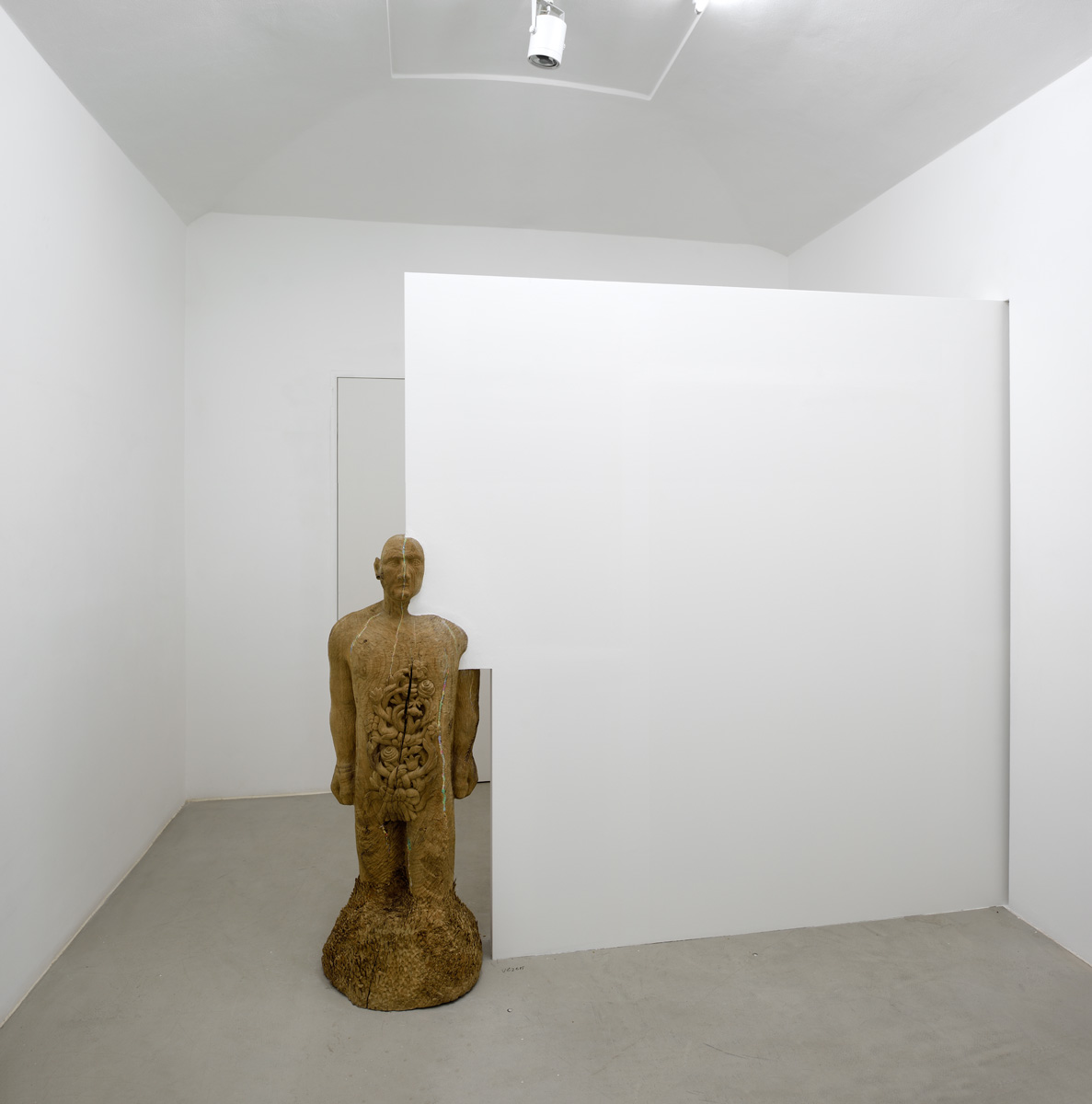INTERPRETER I
& ANNA HULAČOVÁ
A COOPERATIVE PROJECT BY
JIŘÍ PŘÍHODA & ANNA HULAČOVÁ
12|9| – 17|10|2015
Anna Hulačová
In her work, Anna Hulačová (1984, Sušice) explores how folk art – which grew out of and reflected human needs, and should thus be a foundation for our culture – became exotic territory in the 20th century. With an eye towards the questions of national culture and globalized society the 21st century tries (at worst) to mine what is left of folk culture and (at best) to find a new relationship to it. Modernism and the avant-garde, which the 21st century clings to as its rediscovered roots, represent a layover on the journey back to folk art. This situation is reflected in the art of Anna Hulačová, who places great emphasis on handcrafted, primarily sculptural works, on materials that emphasize natural and traditional roots, and on techniques that reflect a sense of sophistication, logic, and symbolism of folk art. Her interests also include devotional sculpture, Christianity and the cultures of indigenous peoples, but also the themes of home and family, which industrial and post-industrial society have lost touch with. Hulačová’s study of ethnography and the past is not just an exploratory expedition or cultural regression – her aim is to find new possibilities for emotion and spirituality in art, however much such formulations will sound pretentiously earnest to the modern intellect.
&
The & in this project stands for many things and offers a complex reading. It applies to each of the exhibiting artists independently, but also to both of them together, and to the gallery itself. hunt kastner gallery has a long tradition of supporting projects by artists who work well as a duo. Past examples include Eva Koťátková and Denisa Lehocká, Alena Kotzmannová and William Hunt, Viktor Kopasz and Geert Goiris, Esther Stockerová and Jan Šerých. In this way, the gallery is perhaps trying to show that it has more than merely commercial ambitions and that it is interested in more than solo exhibitions of the gallery’s artists that focus on the works’ salability. Perhaps they also reflect the gallerists’ sense for a recent phenomenon – the art of collaboration. The & in the work of Anna Hulačová highlights her noticeably frequent collaboration with other artists, including Václav Litvan, Jan Haubelt, Viktor Takáč, and Veronika Holcová. For Jiří Příhoda, the & represents a basic principle of his work, which mixes monumental sculpture with architecture and exhibition design as he alternates between artist and exhibition architect. In his role as artist, Příhoda has also collaborated with other artists, such as the 1998 sound-space installation Music for Prague at Prague’s Nová Síň with Brian Eno. Příhoda’s participation in an exhibition with Anna Hulačová is part of a tendency in contemporary art for artists to take on several roles at once. Příhoda appears here not just as artist and architect as in past exhibitions, but also as teacher – a position he left behind this year.* He has also taken on the responsibilities of curator, selecting Hulačová’s exhibited works from her entire oeuvre and defining their context. Here, too, we can see the “perspective of the teacher” as he watches his student’s progress. Another interesting factor that invites symbolic interpretation is the architecture of the exhibition which, at the same time, is Příhoda’s sculptural work. Its aim is to create a kind of ark, a gallery covenant, that presents Hulačová’s works in such a way that they touch neither the walls nor the floor of the exhibition space. His sculptural exhibition architecture also aims to be a non-verbal interpretation that calls attention to the fundamental values of Hulačová’s work. & thus represents an exploration of the boundaries of artistic media and of the psychology and politics of collaborating and exhibiting.
Interpreter I
The Roman numeral in the title indicates that the interpreter intends to continue in this form of interpretation via the artwork, which is based on the art of another artist and at the same time it creates an environment for the artwork. For Jiří Příhoda (1966, Jihlava), such settings or environments are an important factor in his work with exhibition architecture, and in his older work with objects and film. He always paid attention to a work’s various components and to its setting, in which it can take on various meanings. He has addressed the gallery space and its institutional context in much of his earlier work, including in the Václav Špála Gallery, with a reduced version of the space which he exhibited there, and the hunt kastner exhibition E-SHAPE, E-SPACE, E-SCAPE (2008), which showed the possibilities of remodeling any space into any form and function and completely transformed not only the gallery’s space but also its function, identity, and the way it communicated with the visitor. Příhoda has influenced several generations of Czech artists, especially those who continue to expand upon the foundations of Czech institutional criticism.
* Jiří Příhoda headed the Studio of Intermedia Art II at Prague’s Academy of Fine Arts from 2005 to 2015. Anna Hulačová graduated from the studio in 2012.
Edith Jeřabková, September 2015
 installation view
installation view  installation view
installation view  installation view
installation view  installation view
installation view  installation view
installation view  installation view
installation view  installation view
installation view  installation view
installation view  installation view
installation view  installation view
installation view  installation view
installation view  installation view
installation view  installation view
installation view  installation view
installation view  installation view
installation view  installation view
installation view  installation view
installation view